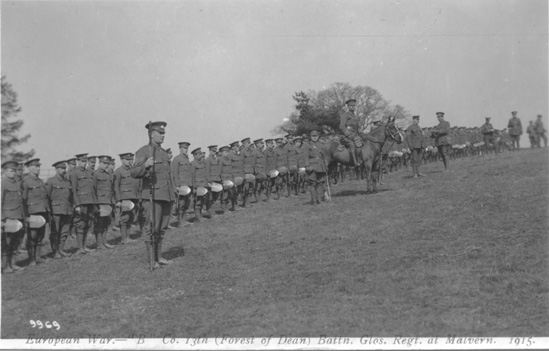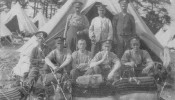The 13th Battalion of the Gloucestershire Regiment was raised at the beginning of the war as a pioneer battalion. The unit trained at Malvern for several months and served in France and Flanders from 1916 to 1918. The following short history has been put together with the help of a local historian, Sam Eedle (who is writing a book on the subject) and has been taken from several of his articles published in local newspapers.

The Raising of the ‘Forest of Dean Pioneers’
By autumn of 1914, the trenches had emerged all along the Western Front. The battle casualties were horrendoucs, and in Britain there were calls for volunteers to replace the losses. Up and down the country, local dignataries responded to the call and raised new battalions, and on Christmas Dy 1914, the Dean Forest Mercury carried the news that the local MP, Sir Harry Webb, was to raise a new Pioneer Battalion from the men of the Forest of Dean. The job of a pioneer unit included digging trenches, wiring and building encampments for other troops, as well as ordinary infantry work. They were paid an extra tuppence a day.
The call went out to miners, labourers, transport workers – anyone used to hard manual labour. They would earn two pence a day more than the average infantryman. Local soldiers enlisted in large numbers from Cinderford as, or course, it was the centre for coal and iron ore mining in the Forest. More miners joined from the North East and South Wales, plus labourers from Birmingham and the ‘three counties’ of Worcestershire, Herefordshire and Gloucestershire.

Officers of the 13th Gloucesters from the Dean Forest Mercury. Lt Col Webb, founder, seated centre. Major A.H. Boulton with dog
The Pioneers at Malvern
The battalion moved to Malvern in the spring of 1915. Major Aubrey Holmes Boulton, adjutant, (and later their Commanding Officer) oversaw the building of an encampment above the railway line on Peachfield Common . “This caused some ill-feeling among local residents who could benefit financially from having the Tommies in their homes,” Mr Eedle told the Malvern Gazette in 1998. “However during their three month stay many friends were made and some local men were allowed to enlist.”
They drilled, made practice attacks and one old soldier wrote that the training included “marching and charging over a hill called Caeser’s Camp (British Camp). It was a strenuous effort, especially on an empty stomach.” The food quickly became a bone of contention at the camp, as it was suspected that the cooks were selling the best meat to local tradesmen, leaving he recruits with the rough and fatty remains. A near riot ensued.
Shortly after this, on 13th June 1915, the battalion was reviewed by Lloyd George, who was a friend of their founder and commanding officer, Harry Webb MP. One bystander asked him about the shell shortage at the front that had caused much consternation. The Welsh mininster roared in response: “We’ll give ’em shells!” The battalion was then, as one member commented “quietly sent up to North Yorkshire and dumped on the moors in the Wensleydale area, supplied with tents and told to build our own camp. Trying to dig through heather roots was very hard work.”
On the 12th July 1915 the battalion was officially taken over by the War Office, and in August was sent to Winchester to join the 39th Division. This formation, a New Army Division was made up, like all First World War divisions, of infantry (three Brigades of four Battalions each), artillery, engineers, medical personnel, cyclists, a cavalry squadron, a vetinerary section and of course, the pioneers.

‘B’ Company, 13th Gloucesters at Malvern in 1915. Courtesy of Sam Eedle
An Apprenticeship in the Trenches
On 4th March 1916, the battalion disembarked at La Havre. After a cold, rough crossing the band was ordered to play the men off. “Their instruments were cold, and it sounded terrible but the drums beat alright.”
The 13th Gloucesters were assigned to a quiet sector to serve their apprenticeship in the trenches. The main role of the Pioneers was to build and repair roads and trenches in the forward areas. Trench repairs were never ending, wear and tear, enemy bombardments and the weather all took their toll and after some bombardments they could be damaged out of all recognition.
They tidied up old battlefieds, made tramways, dugouts, breastworks and shelters; they went on wiring parties, built huts and drained camps. Huts for 15,000 men had to be provided for each Division in preparation for the Somme Offensive in 1916 and many of these were built by Pioneer battalions.
During trench raids and major attacks the Pioneer Battalions, along with their colleagues in the Royal Engineers, were initially kept back in reserve, then at night they moved up and constructed strongpoints and communication trenches between the old British front line and the captured German lines. This support was given in the battalion’s first major action, a diversionary attack before the opening of the Battle of the Somme.
The Mauling at the ‘Boar’s Head’
On the night of June 29th/30th 1916, a Brigade sized attack was launched on enemy trenches that formed a salient known as the ‘Boar’s Head’, near Richebourg L’Avoue. Despite a regular bombardment for the preceeding week, the operation was a disaster. As the second and third waves of the advancing troops went over the top they were caught in the enemy bombardment and, in the word of one member of the 13th Gloucesters “sacrificed.”
The Forest of Dean Pioneers sent four parties in support, totalling nine officers and 285 men. Two parties were ordered to dig communication trenches between the front lines, whilst the other two constructed breastworks on each flank of the attack. The assaulting infantry, who were being shelled and machine gunned as they attempted to cross a dyke in No Man’s Land were prevented from being reinforced and soon ran out of ammuntion. The Pioneers tried to dig amongst the bedlam whilst fighting off sqauds of Germans armed with grenades.
Although the attack failed, the work of the Pioneers was noted by the Brigade staff and a parade of men who took part in the action were read a congratulatory message from the General. However twenty men of the Battalion had been killed and nearly 60 wounded.
The Somme, Passchendaele and The German Spring Offensive
The attack on the ‘Boar’s Head’ was just the beginning. The Pioneers fought on the Somme, where the mud was so bad that the men’s boots were sucked off their feet. The following year, the battalion took part in the Passchendaele Offensive – which proved a miserable affair. Rain fell solidly for the first five days and the 13th Gloucesters were in the ‘Salient’ that entire autumn as a steady flow of men men were lost through wounds and sickness. An officer sought to comfort a casualty’s mother: “… Although, as you know, the conditions out here are often very terrible, and the hardships which the men have to undergo from time to time are altogether indescribable, yet nothing in skill or money or comfort is spared for the welfare of the wounded men. […]” [*1]
Another officer wrote home after a night stint in the ‘salient’: ” … I had a very narrow squeak. I was coming out of the line and was in the rear of the men with several sergeants when a 15-inch shell roared down on us. One could do nothing. I shouted to the men to “scatter” and flung myself down because it seemed to be coming right on to me. We were on what is called “Plumer’s Drive” which is made up with railway sleepers. The Boche were evidently after that to as to interfere with Transport at night. The shell fell a few yards in front of me and made quite a crater in road and scattered the sleepers right and left. I was stunned by the concussion and lay there for some time. When I did get up it was quite dark, and there was no sign of the men. When I got to our Mess everyone was surprised to see me because one of the sergeants had come in and reported that I was blown to pieces.[*2]
Worse was to follow for the Forest of Dean men. During one week of the German Offensive of March 1918, when German forces succeeded in driving the Fifth and Third British armies into retreat, the Pioneers suffered over 300 killed, wounded and missing. They had been preparing fortifications behind the lines near Templeux-le-Fosse when the long-expected German attack broke. After a week of digging trenches, fighting rear guard actions and withdrawing, the stragglers and lightly wounded were collected together and 450 of them were sent as part of a ‘Composite’ battalion to Ypres. On the 26th April, most of them were cut off and taken prisoner by a German attack south of Ypres. Their losses were so bad that they were pulled out of the line. On the 6th May 1918, the unit was reduced to a cadre and attached to the 66th (2nd East Lancashire) Division.
At the Armistice, what was left of the Battalion was to be found near Aumale, France as line of communication troops to 197th Brigade.
Malvern Casualties
Two Malvern men served with the Forest of Dean Pioneers and were killed during the war – both in the German offensives of 1918. Arthur Kyte died of wounds on 28th March 1918 and is buried at Namps-au-Val British Cemetery. Herbert Rodway was taken prisoner in the April fighting near Mount Kemmel and died as a prisoner on 2nd May 1918. He is buried at Dendermonde Communal Cemetery Extension, Belgium.
Lieut-Colonel Aubrey Holmes Boulton
Lt-Colonel Boulton commanded the 13th Gloucesters for the nearly the entire war. He was born in 1882, a son of the Hereford Boulton cider making family. Before the war he moved to Canada working as a solicitor. He returned and secured a commission with the Gloucesters and joined the 13th Battalion when it formed in Cinderford.
He succeeded Harry Webb MP as the commanding officer in Malvern in the summer of 1915. Then he took the battalion to France in March 1916 and with the exception of spells of being sick, wounded and gassed, he remained with them almost for the whole of the war. During his command he was awarded the Distinguished Service Order for his conduct during the battles on the Somme in Autumn 1916.
After the war, he remained as director of his father’s cider-making firm and moved to Malvern. A dedicated sailor he won the Royal Dorset Challenge Cup and the Port of Weymouth yachting trophies. He was also a member of the North Herefordshire Hunt. It was whilst preparing to ride to hounds on Boxing Day 1932 that he was suddenly struck down with a heart attack.
A shelter in his memory was erected near the Wyche Cutting sometime in the 1930s. It remains today and provides shelter to the many walkers of the Malvern Hills.
Notes
[*1] Lieut Martin Smith. Dean Forest Mercury, Cinderford, Nov 23rd 1917. to the mother of Pte William Evans of Cinderford, one of the Battalion’s ‘originals’, who died earlier that month.
[*2] Letter, 13th Nov 1917 Lt R. Henderson-Bland, ‘Actor-Soldier-Poet’ Heath Cranton, 1939.
Acknowledgments
This short history was based on the following articles:
The Forester 7/11/97
Malvern Gazette 31/7/98
Forest & Wye Valley Review 11/5/01
Additional information was taken from James, Brig E A British Regiments 1914-18 London 1978 and original research undertaken by Sam Eedle.
Further Reading
For more information on the 13th Gloucesters see “From the Town Hall to the Boar’s Head” by Sam Eedle, published in the Tewkesbury Historical Society Bulletin No. 11, 2002. This is an 11 page article on the Tewkesbury men who served with the battalion.




